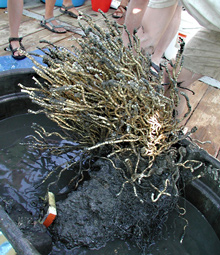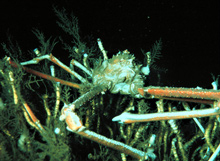
A peek below a tubeworm bush. Large pieces of carbonate rock along with tubeworm roots may block seepage just below the surface and prevent toxic chemicals from reaching the seafloor. Click image for a larger view.
Chemosynthetic Communities in the Gulf of Mexico
Penn State University
Most of the deep sea floor in the Gulf of Mexico is composed of soft, rather featureless, muddy sediment. About 15 years ago, several fascinating discoveries were made in this sparsely populated environment. During a trawling expedition, a bunch of “woody material” was recovered from the bottom. Subsequent investigations revealed that this material was actually a large group of worms living in tubes. These worms resembled some of the tubeworms that lived in the hydrothermal vents of the equatorial Pacific. Additional research expeditions in the area revealed other types of communities, including a few types of mobile clams and extensive mussel beds. We once thought the area was nothing but mud. Suddenly, we found dense groups of organisms living on the bottom of the Gulf.

A small bush of tubeworms. When tubeworm bushes are young, only endemic species of animals can colonize them. The presence of the mussels (Bathymodiolis childressi) in the center of the bush means that methane is seeping just below. Click image for larger view.
Why were these large groups of animals living there? Normally, in the deep sea below the depth to which light will penetrate (the photic zone), animals are scarce because they can only feed on whatever floats down from the surface waters. But the high densities of animals at these sites suggested the presence of another food source. Eventually, we learned that these communities were chemosynthetic. Chemosynthesis is a process very similar to photosynthesis, but chemical energy is used instead of light energy to make food from the carbon in carbon dioxide.
We discovered that there were large amounts of bacteria—groups large enough to see with the naked eye—serving as a food source for many organisms. In addition, many of the organisms in these areas had developed a symbiotic relationship with bacteria. The tube worms and clams hosted symbiotic bacteria that used the chemical energy in hydrogen sulfide, and the mussels hosted bacteria that fed on methane. All of the chemicals were found in very high concentrations at the sites where these animals lived—cold hydrocarbon seeps.

TA peek below a tubeworm bush. Large pieces of carbonate rock along with tubeworm roots may block seepage just below the surface and prevent toxic chemicals from reaching the seafloor. Click image for a larger view.
Many other animals are associated with these chemosynthetic communities because of this increased productivity. At first, many small, grazing animals, such as snails and shrimp, move into the areas and eat large numbers of bacteria. They are able to withstand the high concentrations of chemicals in the area. This is an important characteristic because normally, the amounts of methane and sulfide needed by the free-living and symbiotic bacteria are at toxic levels to most animals. Only those animals that can tolerate these chemicals can colonize the seeps at first. Their resistance to these chemicals allow them to gain a refuge from the large predators in the area. These animals also are almost all endemic species, which means that they are unique to a particular geographic location—in this case, seep sites.
Eventually, however, seepage rates decline and the amounts of toxic chemicals in the environment diminish. It is possible that the large amounts of chemicals that the tubeworms take out of the sediment actually lower the concentration of hydrogen sulfide in the water.

A large spider crab crawling over a group of tubeworms. These predators are found throughout the Gulf of Mexico. They move into tubeworm bushes after seepage rates decline, to prey on small animals. Click image for larger view.
And as their roots grow, they also may fill in the cracks in the rock on which they live, thus preventing the chemicals from making it to the sediment surface.
The rate of seepage of these chemicals eventually slows, allowing other non-endemic animals that live all over the Gulf to move into these sites. These animals may include species of filter-feeding sponges and hydroids as well as predatory crabs, seastars, fishes and sharks. Interestingly, it appears that the predators come in to eat some of the small snails and other grazers, but they do not eat the tubeworms. It is possible that all of the bacteria inside the tubeworm render it too toxic for the predators to digest. Predators take advantage of the tubeworm habitat by hiding in the bushes and waiting for food to swim by.
We expect that as we collect samples from different sites around the Gulf, we will find the same endemic species, though we may be surprised. Hopefully, we will be able to satisfy some unanswered questions when we explore more new seep sites.
Sign up for the Ocean Explorer E-mail Update List.























